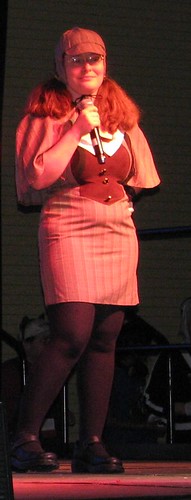 Opening Ceremonies
Opening Ceremonies
Opening Ceremonies was never something I used to attend, but lately I’ve found that it helps set the mood of the con. This year’s Mystery and Mayhem offered a playful air that lent to some intentional and unintentional laughs. The ever-energetic and always entertaining Uncle Yo, joined on stage by Detective Con Chair (Matilda Madden), introduced guests via trivia-based clues hidden under seats reserved for VIP attendees. Seeing as the show started at 1:00 pm on a Friday, however, there weren’t bodies in some of those special seats. So Yo got a bit of a workout hopping on and off stage to pluck clues, but it was entertaining to watch him do so. Even before things got underway, Yo was chillin’ on stage with Kyubey (from Madoka), offering over-exaggerated reactions to the A/V content being shown, which included (among others) a Durarara!! chat parody and Underbelly’s Pokéholics Anonymous. Speaking of which…
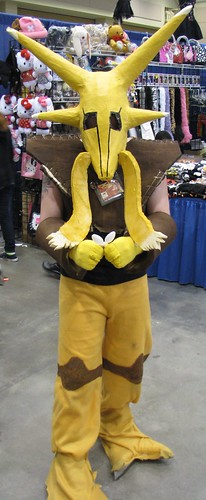 Joseph Campbell Sends Out Mew: Pokémon Mythology
Joseph Campbell Sends Out Mew: Pokémon Mythology
Even if you’re not into Pokémon (and how dare you not be, you horrible human being), attending this panel is worthwhile if not eye-opening. Sure, he uses the Pokémon OP and brand to lure people into the room, but what panelist Charles Dunbar actually does is examine the interactivity of an ever-evolving mythology. Wielding Joseph Campbell theories like six-shooters, Dunbar charmingly connects the theoretical to the actual to reveal the extent to which Pokémon integrates homages to Japan’s historical and contemporary culture via the physical and behavioral traits of said pocket monsters. Sure, that may sound a bit dry, but as proof to the contrary, there was a girl of maybe six or seven in the first row so entranced with the panel that she didn’t say a word. She wasn’t sleeping or dazing off either; she was filling in her parent at points as to what was being discussed and asked Charles a few good questions too! So overall, a fun and educational panel for fan and non-fan alike.
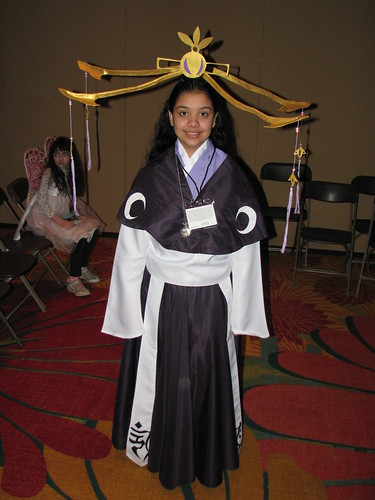 Women in Anime
Women in Anime
Led by Ellyn Stern, what I had hoped would be a retrospective on some 30 years of anime industry experience regarding the roles of women (both on and off screen) regressed into an interview of the audience regarding their anime heroes and riajuu aspirations. Stern seemed to not have kept up with anything outside of her own roles in anime, constantly stating “anime is dead.” She also repeated how there are no good role models for women in anime, which is in part due to anime having been primarily created by and for a male audience. Stern also stressed the need for the non-objectification of women and real stories in anime, roles expressive of the female condition where women can just be women. Most of these I consider valid, but I’m condensing almost all of the good points into a couple sentences, whereas the panel lasted a full hour. At its worst, Stern’s stream of consciousness seemed like that of a spin doctor with anterograde amnesia. At its best, her out-of-touch ponderings managed to bring up poignant questions and remind listeners that we should never stop questioning.
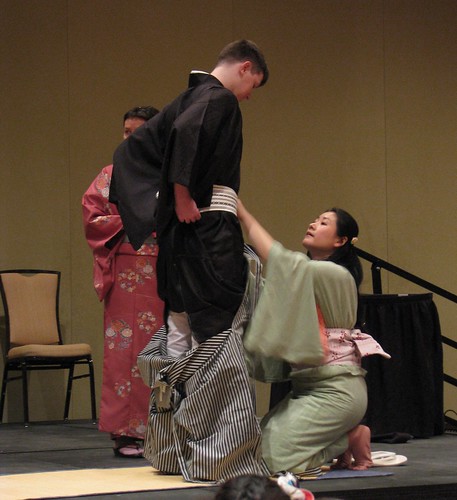 Kimono Show with Kuniko Kanawa
Kimono Show with Kuniko Kanawa
Did you ever catch a line in anime/manga where one character is amazed another character managed to dress him/herself in traditional garb? Did you laugh? Did you shrug it off? Did it baffle you? Well it turns out that there’s good reason for the portrayal of such astonishment! Kuniko Kanawa and assistant, while dressing 2 volunteers (and the assistant), gave some brief historical notes about the specific outfits. It became very clear that the act of getting dressed in such attire is an art unto itself. This was not at all influenced by the soft and soothing classic music playing in the background or the grace with which Kanawa looped and folded and tightened. Demonstrations included the way to properly don a hakama, the type samurai wore; tie the obi (sash) on a furisode, or swinging arm kimono; and tie the obi on more casual attire.
Sakura Cosplay Ball
This was definitely not the junior high school dance where boys and girls got all gussied up and then plastered themselves against opposite sides of the auditorium. If the anime characters from the stories we treasure popped off their discs and into the real world and started to ballroom blitz dance, you’d have the Sakura Cosplay Ball. Ok, it was actually Set Dancing, a type of folk group dancing, but it was still pretty impressive. Cosplayers from all wakes of fandom convened in a large room with bright, polished wood floor and watched as an instructor demonstrated a dance that they would soon repeat. Backed by a live ensemble, characters stumbled, smiled, and swayed (some even with elegance) with multiple partners to newly learned steps. As much fun as participating looked, looking on was just as much fun. All the more incentive to cosplay next year! Here’s a short video of one of the dance moves.
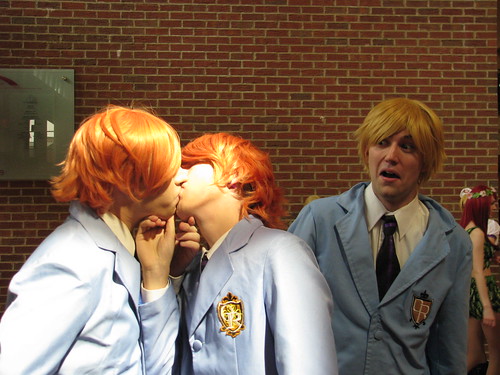 Cosplay Burlesque
Cosplay Burlesque
I’m guessing you know what cosplay is. I know you have enough aptitude to Google the term burlesque if you don’t know what that is. Combine those two terms and you get Cosplay Burlesque! Hosted by Uncle Yo and featuring the Cosplay Burlesque troupe, this show presented sides of cartoon and video game characters you’ve only seen in doujinshi. All the men and women of this outfit, be they svelt or Rubenesque or anywhere in-between, had some serious moves. As playful as the show was during and between numbers, I can only say that the finale still makes me giggle in my sleep and wake up in a cold sweat. This was an event I’m overwhelmingly happy I chose to attend at the last minute.
Saturday Morning Cartoons of the 80’s and 90’s
The best thing about this panel by Kevin Bolk of Interrobang Studios was the stroll down memory lane. The worst things about this panel by Kevin Bolk of Interrobang Studios were the realizations that A) I have spent the majority of my life watching cartoons, B) I had forgotten the majority of them, rendering that investment of time null and void, and C) the reintroduction of these long-since suppressed atrocities of animation into my conscious and completely sober mind at 9am leaves me with more shame than can ever be confessed. I remembered the unadulterated LOVE I held for these horrible, horrible cartoons as a kid. Bolk tried to soften the blows of the offending material by showing the progression — the milk-this-tide-for-all-it’s-worth — that seemed the motto of the ’80s animation industry. In the end, there is no option but to laugh at yourself, because, let’s face it, laughing at children and what they adore is damned fun times.
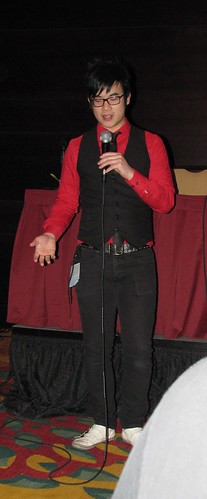 How Being Asian Got Me Into Trouble
How Being Asian Got Me Into Trouble
Simon Young, bass player for The Slants, offered up a “collection of personal stories and some other interesting tid-bits [about] playing in an Asian band, kinda growing up as an Asian American here in the states.” Seldom do you get a chance to bear witness to such an honest and intimate divulgence as this at an anime convention, and even more rarely is it from a featured guest. As the standard holds true, enough time has passed for much of Young’s tragedies to be leveraged as comedy amongst those who’d offer chuckles of sympathy. Young started with growing up and the internal and external influences that contributed to the stripping of his heritage in order to fit in with a culture that refused to accept him as anything but secondary, be it via institutional marginalization or schoolyard bullying. He continued with various encounters of ignorance, both well-meaning and unintentional as well as the opposite. At some point while describing the lengths to which his band went and consequentially won over prejudicial audiences, I fell in love with the depiction of the band’s energy enough to attend their show. I’d like to think of this panel as preaching to the choir, but, hell, if one person’s understanding or sense of compassion is broadened as a result of attending, then this type of panel should appear at more cons.
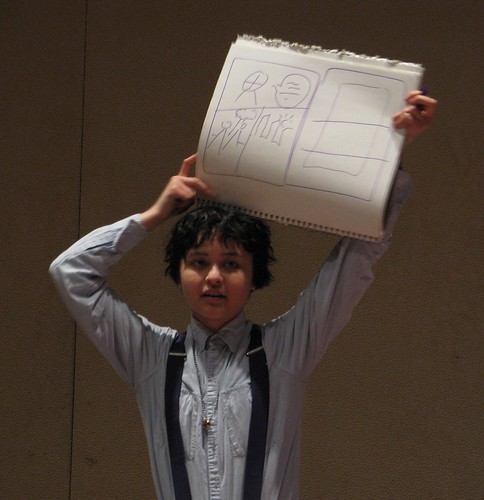 Creating Manga from Start to Finish
Creating Manga from Start to Finish
This didn’t quite turn out to be what I expected, but not in a bad way. Instead of a step-by-step, orated or visual guide to making a manga, Lily Cernak, author and illustrator of Farewell Feeling, took suggestions to address specific proposed by the audience. Whether she arranged the requests during the panel or they just happened to work out in a decent order, what resulted was a decent set of exercises. These included panel setup, considering print limitations, storyboarding techniques, how to draw faces, as well as creating “looks” and ways of using them to deceive readers for the purpose of the story. While much was covered, it felt as though the explanation of the reason behind most elements was lacking; this can most likely be chalked up to a lack of time. All things considered, this was an involving and decent intro into several aspects of the art.
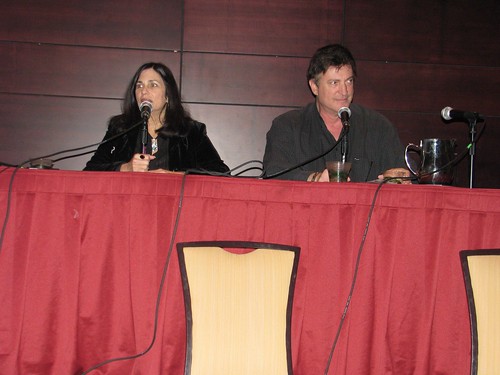 Acting and Directing with Richard Epcar and Ellyn Stern
Acting and Directing with Richard Epcar and Ellyn Stern
If you’ve never been to a Q&A with those who create what you love, this is a great place to start. Epcar and Stern are, like most on the U.S. side of the anime industry, very happy to have jobs. Unlike most in the industry, they have 30-some years of experience. Because of that and because of their occupational roles, they have watched the scene grow to what many take for granted today and have the insight into what’s going on behind the scenes currently. This does not take away a bit from their comical banter and lighthearted approach to answering any and all sorts of questions. Whether speaking to changing roles for veterans and the accessibility of the industry to interested newcomers, their own personal history in performing and the like, voice care tips, or recalling voices from past roles, Epcar and Stern certainly didn’t pull any punches when answering questions but always kept the mood light with smiles and jokes. You’ll learn quite a lot without feeling like you are, and you’ll love doing so.
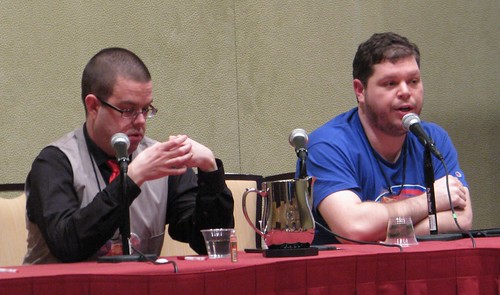 Changing Faces of Anime Cons
Changing Faces of Anime Cons
Looking back at 30 years of anime conventions, Doug Wilder of AnimeCons.com, joined by Charles Dunbar, examined what was, what happened, and what is. Lots of interesting tidbits in this panel. Aside from the general history – the whens, wheres, and whoms – and statistics, the panelists dug into such areas as anticipation as well as content nature and diversity. It’s easy enough to take for granted the here-and-now of anime conventions if you’ve recently taken that almost baptismal plunge into submersing yourself amongst fellow devotees. But to those who dared to break ties with that which spawned them, today’s scene is a thriving community. As opposed to older fans screaming in your ear, “You can’t possibly appreciate what you have today, because you’ve always had it this good,” this panel fosters true appreciation and humility by showing how good we have it compared to 1983.
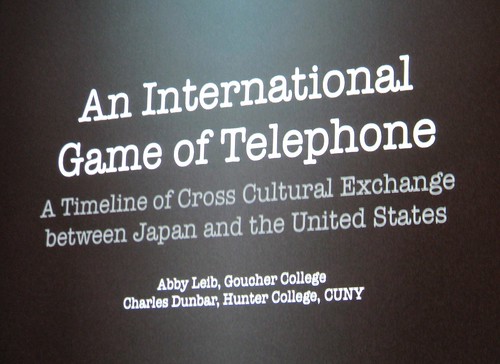 An International Game of Telephone
An International Game of Telephone
Japan and the USA have a longstanding tradition of borrowing ideas from one another, doing something to them, and then sending them back. Likening this history of exchange to the game of telephone — where one message turns into something different after being told sequentially by multiple people, Charles Dunbar explains the syncretism which drives culture in the USA and Japan. Aside from the obvious link between Tezuka and Disney (and The Lion King and Kimba the White Lion for the vice-versa), Dunbar put together a number of aspects of culture — animation, food, music, cinema, manga — that when laid out and presented as cause and effect seemed a series of tennis returns. In addition to a range of examples, Dunbar also examined the psychological drive behind Japan’s adaptive nature, what has accelerated the nation’s exchange (e.g. the Internet) with the world, and the sometimes sensitive nature of the adaptation (if not outright theft) of ideas. But really, you want to go see this panel to hear the panelist say “Anime rocketed from underground to mainstream because of little monsters and their balls and a spaceman” and sit in awe of just how right he is.
